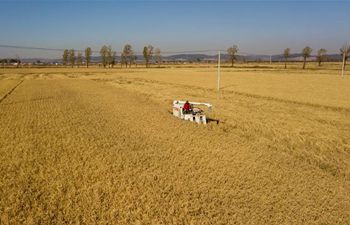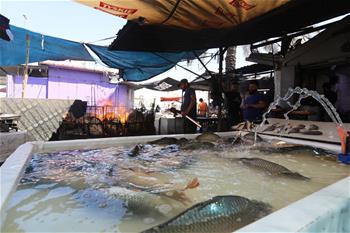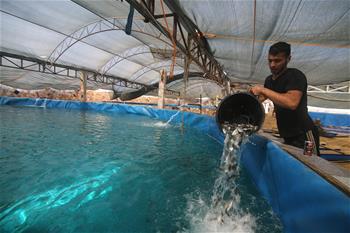KAMPALA, Oct. 16 (Xinhua) -- Before dawn breaks, everyday in Uganda's capital Kampala, truckloads of fresh food produce from across the east African country are offloaded.
Experts consider Uganda as the food basket for East Africa because the country exports some of the food produce to neighboring countries like South Sudan, Kenya, eastern Democratic Republic of Congo, Rwanda and Burundi.
Despite this abundance of food, there are parts of the country that have worrying malnutrition levels, according to the ministry of agriculture.
As the world commemorates World Food Day on Wednesday under the theme -- "Our Actions are our Future. Healthy Diets for a Zero Hunger World", the agriculture ministry says more effort is needed.
COST
According to the agriculture ministry, Uganda's Global Hunger Index (GHI) is 33 percent, implying one in every three Ugandans face acute food insecurity.
The overall nutrition status in the country as per GHI indicators shows that 33 percent of children below 5 years are stunted, 22 percent are underweight and 6 percent wasted.
Twenty-two percent of women suffer from maternal malnutrition while 30 percent of men are undernourished mainly due to low food intake and alcohol consumption. Eight percent of population in urban areas is overweight and obese due to over-nutrition
This situation has had an impact on the country's financial resources that would have been used to fast track development.
According to the ministry of agriculture, studies have shown high anemia rates leads to a 335 million U.S. dollar productivity loss.
Annually close to 170,000 children are born underweight and this leads to 5 million dollars spent on incubation facilities while 16,000 who die of low birth weight cause a loss of 38 million dollars.
Uganda continues to face the challenge of a rapid population growth rate of 3.2 percent annum; while agricultural productivity is at 2.9 percent per annum. The three percentage point food gap must be addressed if the is to move towards Zero Hunger by 2030 as per the United Nations Sustainable Development Goal two.
ROLLBACK
Vincent Ssempijja, minister of agriculture, in a statement issued ahead of World Food Day said the country has a series of policies aimed at addressing natural resources management issues, food security and call for "Nutrition for All" interventions to improve the nutrition status in the country.
Ssempijja said state-owned organizations like National Agricultural Research Organization are at the forefront of bio-fortification. The researchers enhance nutrient quality of staple foods like protein rich maize, iron rich beans, zinc in bananas, sweet potatoes among others.
"These high yielding crop varieties are being promoted in many communities to improve nutrition status of our people," he said.
Areas that face more serious hunger and nutrition challenges, government has put a range of nutrition interventions which will require investment worth 213 million dollars over five years.
"A Zero Hunger World by 2030 is possible. Studies have shown a dollar invested in hunger prevention returns between 15 dollars and 139 dollars in benefits. This is achievable if all stakeholder in the agriculture sector and farming households play their roles to ensure food and nutrition security, household incomes and exports," Ssempijja said.













